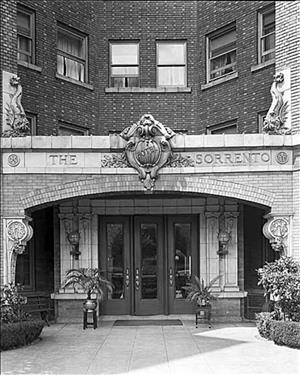On May 30, 1909, The Seattle Times lauds the newly opened Sorrento Hotel as a "credit to Seattle." The 150-room hotel opens just in time for the Alaska-Yukon-Pacific (A-Y-P) Exposition, a world's fair that will open June 1st at the University of Washington campus. Designed by Harlan Thomas (1870-1953) for Samuel Rosenberg (1859-1916), a local clothing retailer, the luxury hotel includes design elements inspired by the Italian town for which it is named. In a city not far removed from its pioneer days, The Sorrento embodies the sense Seattleites have on the eve of the A-Y-P that Seattle has arrived on the world stage. The hotel remains open a hundred years later, its elegance rejuvenated by restoration work in the 1980s.
A Credit to Seattle
At its opening, The Seattle Times fawned over the hotel. In 1908 and 1909 numerous hotels opened in Seattle to accommodate A-Y-P visitors (which numbered 3.7 million), but The Sorrento seems to have drawn special attention from the paper due to its location and design. It was perched on First Hill at Madison Street and Terry Avenue, and the Times lauded the hotel rooms' view of "the tide flats, the manufacturing plants of that portion of the city, the harbor and Sound, West Seattle, Eagle Harbor, Fort Lawton, Smith's Cove, the Olympics, Queen Anne Hill, Lake Union, Ballard, Fremont, Capitol Hill, the Cascades and Mount Rainier" ("Recently Completed Hostelry Which is a Credit to Seattle"). Architect Harlan Thomas situated all of the rooms on the west or north sides to take in the view, which, the Times claimed, "No amount of building can ever obstruct." The newspapermen did not envision the skyline as it is today, filled with skyscrapers that have redefined the view from The Sorrento Hotel.
Thomas drew upon Italian antecedents for inspiration. He designed the hotel in the Italianate (also known as Italian Renaissance) style, with arched windows and doorways, wide eaves with brackets, and a hipped roof. On the roof, adjoining the ladies' tea room, a Florentine-style loggia (an arched, covered arcade) opened onto the rooftop and its spectacular views.
An Ideal Home
The Seattle Times called the hotel "an ideal home," alluding to the role of many hotels during that era. In addition to hosting visitors to the city, they often served as long-term residences for newcomers to the city. Seattle experienced a tremendous surge in population growth in the first two decades of the twentieth century and hotels like The Sorrento provided housing in a tight market.
The Sorrento has the distinction today of being Seattle's oldest hotel still serving its original purpose. Many other early Seattle hotels have been converted into apartments or torn down. Although numerous renovations, and the growth of the city around it, have changed some of the particulars of the building, The Sorrento remains a distinctive address in Seattle.

